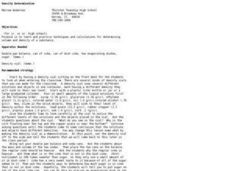Curated OER
Pop Shop 4 - Shopkeeping
Students create a store where they sell pictures, tee shirts, and prints. In this store lesson plan, students learn about sales, marketing, and how to run a business.
Curated OER
Relating Maya
Students read about the bags that the Maya people made and about how reusing bags can help save our environment. In this environment lesson plan, students read and discuss conservation and observe pictures.
Curated OER
Density Determination
Students observe 2 demonstrations of density. In this density lesson plan, students observe a vial with various substances of different densities. Students then observe the differences between a diet coke and a regular coke can when on a...
Curated OER
The World in a Classroom
Students calculate percentages of different kinds of people in the world. In this diversity lesson plan, students will see the percentages of different people and different incomes based on if the world only had 100 people in it.
Curated OER
Parachutes: What a Drag
Sixth graders make 2 different kinds of parachutes and record and graph the time for each one for the different drag forces. In this parachute lesson plan, 6th graders compare the results to the rest of the class of each parachute and...
Curated OER
Reducing Rain Runoff
Students compare roofing materials to determine which ones reduce rain runoff. In this rain runoff lesson plan, students use a milk carton, stickers, soil, and more to create this activity.
Curated OER
A Little Horse Sense
How have horses evolved over time? How do horse skulls reveal this evolution? How have the roles horses play changed over time? What kind of social structure do horse herds have? How should wild horse populations be managed? To find the...
Curated OER
CyberHunt: Digging for Dinosaurs
Students discover dinosaur facts using internet research. In this 2nd - 3rd grade lesson plan, students identify various dinosaur facts. Students use internet research to answer questions regarding dinosaurs.
Curated OER
Strangers
Students learn and discuss what to do when approached by a stranger. In this stranger lesson plan, students answer questions based on a book that the teacher reads. They then participate in a discussion about rules and guidelines to...
Curated OER
Germination: Name that Seed
High schoolers investigate seeds, flowers and germinating seeds. In this germination lesson plan, students observe a stalk of corn, a corn seed, Gladiolas and glass jars containing germinating sees and plants. High schoolers answer 8...
Curated OER
The Role of Enzymes
Learners explore the role of enzymes in chemical reactions. In this enzymes lesson plan, students use hydrogen peroxide and manganese dioxide to observe a chemical reaction. Learners observe the rates of reactions of chalk, hamburger,...
Curated OER
Biology Trivia Questions
Students answer 71 questions about a variety of topics in biology. In this biology trivia lesson plan, students use the internet to find the answer to questions about the systems of the body, their structures and functions, the different...
Curated OER
Physical and Chemical Change of Six White Substances
Students investigate chemical and physical changes in reactions. In this chemical and physical change lesson plan, students mix 6 different white substances with water, vinegar and iodine. They make hypotheses about each substance and...
Curated OER
A Guinea Pig Makes An Excellent Classroom Pet
Third graders live alongside guinea pigs. In this biology lesson plan, 3rd graders gain direct knowledge of the guinea pig's behavior and determine if it will make a good classroom pet.
Curated OER
Electricity: Static and Current
Young scholars investigate static and current electricity. For this electricity lesson plan, students observe 4 demonstrations and conduct 3 activities to explore the repulsion of electrons and the attraction of protons and electrons....
Curated OER
Burning vs. Heating
Students investigate burning vs. heating and observe the differences. In this burning vs. heating lesson plan, students observe a wooden splint burning and a piece of glass tubing being heated. They answer questions to compare the two...
Curated OER
Relative Masses
Students investigate relative mass using 8 different items. In this relative masses lesson plan, students discuss as a class John Dalton's atomic theory. They take the masses of the 8 items and record their data. They discuss relative...
Curated OER
Mole Relations
Tenth graders investigate the mole using raisins, sunflower seeds and M&Ms candy. In this mole relations lesson plan, 10th graders create trail mix packets using the food items given to them using "dozen" as the units. Students write...
Curated OER
How do animals survive winter?
Students make a chart about hibernation. For this hibernation lesson plan, students discuss hibernation and read about it. Then they fill in a chart about how different animals know when and how to hibernate.
Nemours KidsHealth
Germs: Grades 3-5
Students investigate personal health issues by discussing germs. In this contagious disease lesson plan, students identify ways germs infect our bodies and how we can best protect ourselves. Students discuss food preparation and safety...
Curated OER
Mixing and Stirring
Students experience mixing through dancing. In this physical science lesson plan, students not only dance to show mixing but also demonstrate mixing and stirring by combining milk and chocolate milk.
Education World
Teaching Students to Tell Time: Three Resources for Busy Teachers
Elementary schoolers develop time-telling skills, one skill at a time. They examine the connection between time on digital and analog (clock-face) clocks. An excellent lesson plan on teaching how to tell time!
Curated OER
Adapting the Game Concentration
I love classroom games, and this plan deftly describes how you can use the game Concentration across the curriculum to reinforce skills. I wish I would have thought of this when I was teaching this age level. These kinds of games are...
Curated OER
Data Collection
Students write a journal exercise that relates to pets. They collect information from each other in order to practice making and interpreting bar graphs. They Continue building different kinds of graphs with the group.

























